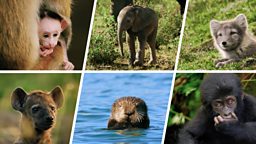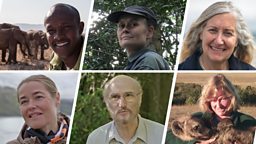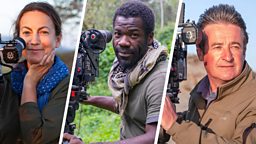Meet the animal babies
It took a great deal of research, patience and nerve to wait for each of the babies to arrive. The team had to find successful animal families in the wild that had been monitored by scientists for years, so they could be sure that they could identify all the family members as well as the babies.
Savanna Elephant
(Loxodonta africana)
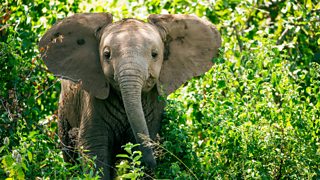
Safina (female)
Samburu & Buffalo Springs National Reserves, northern Kenya
- Lifespan of over 60 years.
The Storms 1 Herd, led by 46-year-old matriarch and mother of Safina, Cyclone. This is a small herd of nine elephants, made up of three breeding females and their young. Safina has three brothers aged 15, 11 and 6 years old. Babies are born on average only every five or six years, so with only three mothers in this herd it was exciting to find two babies born within two weeks of each other. However, this does mean the likelihood of both calves, especially as they are both girls developing very close, lifelong bonds is high.
Mountain Gorilla
(Gorilla beringei beringei)

Nyakabara (female)
Bwindi Impenetrable National Park, Uganda
- Lifespan of perhaps 40 to 50 years
The Mukiza Group now has 13 members, including Nyakabara’s 16-year-old mother Twijykye, and her 17-year-old father Mukiza, the troop’s silverback. Nyakabara’s half-sister Gorodi was 16 months old when she was born. When Nyakabara was eight-months-old another baby was born, Kagote, which meant that the troop had three infants under two years old. Since filming finished Nyakabara has become much more independent in the forest and is very close to her playmate Gorodi.
Spotted Hyena
(Crocuta crocuta)

Bisque & Chowder, (females)
Mara Conservancy, southern Kenya
- Lifespan of around 12 years
The North Clan is one of three study clans in the Mara Conservancy. The twins’ mother, 4-year-old Soup, is the second female in command, and their great grandmother, Waffles, was the queen during filming. Waffles doesn’t have any surviving daughters to succeed her, so since filming she has let the crown go to her granddaughter Soup. That means Bisque and Chowder are now hyena ‘princesses’.
Southern Sea Otter
(Enhydra lutris)
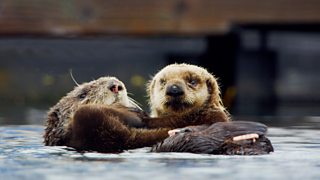
Limpet (male)
Monterey Bay, California, USA
- Lifespan of 15 -18 years
Limpet’s mother is ‘Sandy’, who is 11-years-old. Male otters do not play any part in parenting and mothers separate from their single pups when they are around six months of age. Monterey Bay Aquarium don’t usually ID tag otters unless they are rescued and in distress, but after following Limpet for filming for so many months they decided to try to tag him, so they could continue to track his progress after he left his mother. Unfortunately weather conditions and water visibility did not allow for it, so his survival and whereabouts are unknown.
Toque Macaque
(Macaca sinica)
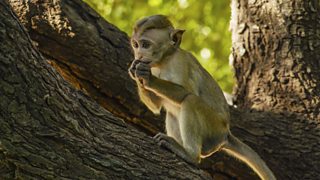
Jazir (male)
Polonnaruwa World Heritage Site, Sri Lanka
- Lifespan of around 30 years.
Jazir's mother is the alpha female, Jamusa. Jazir’s father could be the alpha male of the troop, but this isn’t guaranteed as sometimes lower-ranking males, sneak in to mate with females. The troop is made up of around 34 macaques, but young males will begin to leave the troop as they reach 4 or 5-years-old. Another baby, JB, was born five days before Jazir, to one of the lowest ranking mothers. Sue was also filming JB but sadly six months after filming finished, he died, probably of malnutrition.
Arctic Fox
(Vulpes lagopus)
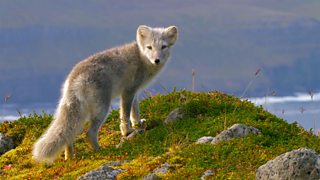
Fela (male)
Hornstrandir Nature Reserve, Westfjords, Iceland
- Lifespan of only 4 – 6 years in the wild in Iceland.
Fela’s mother is unnamed , but his father is known as ‘White Toe’. Elsewhere in the Arctic region Arctic Foxes hunt lemmings that hide under the snow. In some years lemming populations boom and Arctic Foxes have been known to have litters of 14 cubs. There are no lemmings in Iceland, so litters tend to be much smaller – around eight cubs. The Hornstrandir foxes hunt for seabirds, chicks and eggs on 300-metre-high sea cliffs. If Fela survives the winter then he will have to learn to hunt seabirds to thrive.
